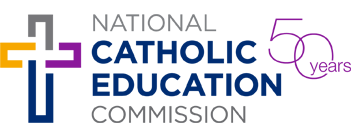Behaviour management planning for students with high needs
or challenging behaviours
Introduction
The HUB program at St Patrick’s Primary School, Lithgow is a targeted intervention program for students with high needs or challenging behaviours who may be experiencing barriers to successful engagement in the classroom.
Principal Renae Dunleavy commenced at St Patrick’s, a Catholic Education Diocese of Bathurst school, in mid-2019 at a time when the school had a high proportion of students with additional needs. Classroom teachers and support staff were experiencing difficulty in classroom management and responding to the needs of students.
Since mid-2019, the school has implemented a focus on quality student engagement which involves:
- professional learning delivered to staff with the aim of embedding a whole school focus on creating and maintaining a safe, settled environment
- setting clear and consistent expectations for behaviour across the school
- embedding common language around expected behaviours
- implementing school-wide routines and strategies that are designed to increase student engagement and set students up for learning success.
St Patrick’s restructured its support team to ensure that the work being done with the highest needs students became more explicit and targeted to individual needs, with the aim of setting students up for successful engagement in the classroom. It also implemented a strong focus on supporting student mental health and wellbeing.
From the restructure of the support team the HUB program evolved, which is an initiative to support students with the highest needs by teaching them the explicit skills required to fully function within the classroom environment. The HUB program was in its infancy from 2020 – 2021 and was fully implemented in 2022.
Since the establishment of the HUB program there has been a 64 per cent decrease in major and minor behaviour incidents from 2020/2021 to 2022/2023 data and a 32 per cent increase in enrolments.
Main image: St Patrick’s Primary School, Lithgow principal Renae Dunleavy with assistant principal Lyndall Marshall
The HUB program
The HUB is an extension of the support team, focusing on the specific areas of need that often prevent full engagement in the classroom for individual high-needs students.
The program seeks to understand the needs of targeted students and the aspects of school they struggle with, by working with individual students to assist in their ability to understand and regulate emotions such as stress and anxiety. It aims to increase engagement, participation, independence and success for students.
The HUB also provides support staff with the time to focus on explicit teaching of skills that are crucial for classroom engagement to support the classroom teacher and, in turn, the student. The consistent and predictable routine of the HUB allows for these skills to be taught, consolidated and fully embedded into the student’s daily routine.
Once students are equipped with consolidated skills, that they have had the opportunity to practice regularly, they will be able to navigate the school day with greater success and be able to engage and participate more fully in the classroom.
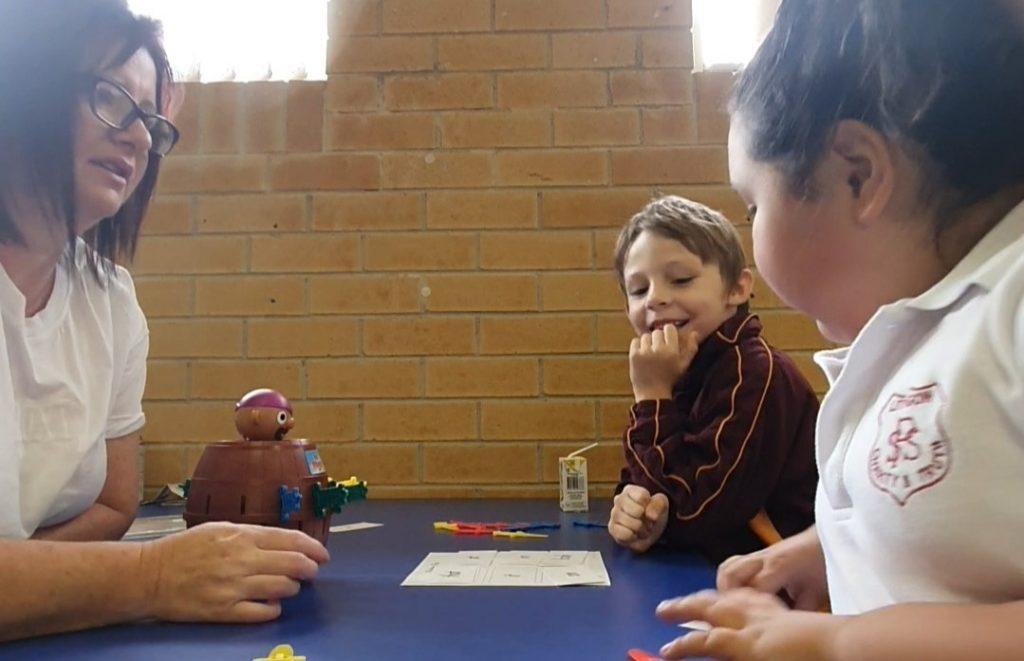
The HUB is a physical space staffed by the schools’ support teachers. Support teacher Nicola Collins works with students in the HUB.
St Patrick’s school principal Renae Dunleavy said the HUB was not a minding service for students who weren’t coping or who were misbehaving. “It is not a place for ‘down time’, it is not a ‘one off’ place,” Ms Dunleavy said. “Students are targeted to attend ongoing sessions in the HUB. It is a proactive strategy rather than a reactive strategy.”
Behaviour management planning
Aim of the HUB program
The HUB program aims to:
- provide a solid system within the school that is designed to cater for and support students with additional needs in order to increase their engagement, participation, independence and success in the classroom
- lessen anxiety and stress for students with additional needs by providing a ‘springboard’ to the classroom each day that centres on predictable routines, clarity around expectations and consistency
- equip students with additional needs with the skills required to succeed in the classroom through explicit teaching, practicing and consolidating skills on a consistent basis
- support classroom teachers in understanding the needs of the more complex students and working in collaboration to improve practices as a professional learning community
- support families of students with additional needs and work in partnership with them around the students’ individual needs and goals.
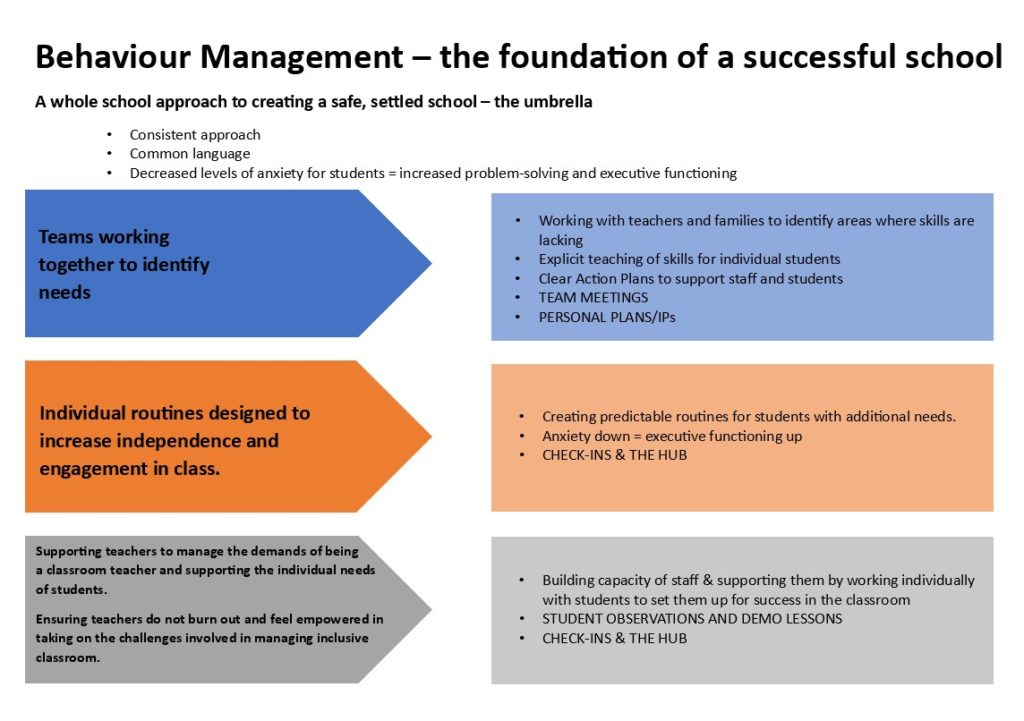
How the program is delivered
The program delivers:
- predictable daily routines in the HUB for targeted students. These daily routines involve individualised programs of work for student with additional needs focusing on:
- navigating the school day successfully and with independence using social stories, mini routines and explicit teaching of targeted skills
- programs tailored to individual needs e.g. Move to Learn
- supported transitions to the classroom
- creating a ‘safe space’ for students if respite from the classroom is required
- providing a place for ‘passive play’ during break times if required
- explicit teaching of targeted skills daily to assist students with additional needs in navigating the school day successfully
- explicit teaching of skills that aim to develop self-regulation skills that allow students with additional needs to cope with daily demands
- working with classroom teachers collaboratively on personal plans and individual goal setting in order to ensure a team approach in enhancing student engagement and success in the classroom
- engaging families in planning and implementing individualised programs for those students with additional needs.
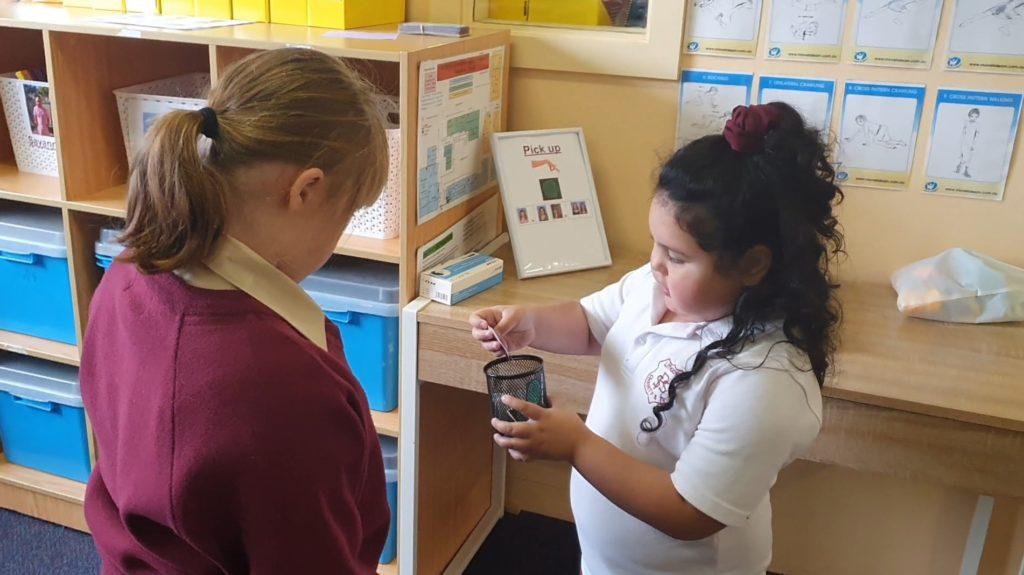
Students getting their ‘safe ticket’ to transition back to the classroom after their morning HUB routine. Each child has individualised routines to set them up for success every day. The routines are designed to decrease anxiety through the creation of highly predictable routines.
Data and evidence
Ms Dunleavy said the school recorded a 64 per cent decrease in the number of major and minor behaviour incidents when comparing 2020-2021 Term 1 and 2 data with 2022/2023 data.
“The HUB program had transformed the school’s support team who are now working cohesively rather than in isolation, with clear and specific goals and targets,” Ms Dunleavy said.
“There has been great success in the students transferring the skills developed in the HUB to the classroom, allowing the student to engage and participate independently.
“The support team has been able to further support teachers in engaging students with additional needs and challenging behaviours, looking at the skills that they are lacking and designing individual interventions designed to build these skills.”
Nationally Consistent Collection of Data (NCCD)
With the evidence of adjustments provided within the HUB program, and in turn recorded within the NCCD, the school has seen a 125 per cent increase in the Students with Disabilities funding received this year.
Enrolment data
There has been a 32 per cent increase in enrolments since mid-2019 (see Table 2) when the school began working on quality student engagement and creating safe, settled environments. New families reported they were attracted to the school’s focus on creating a safe, settled environment.
Table 2: Enrolment Data.
| Enrolment Data | 2019 | 2020 | 2021 | 2022 | 2023 |
| 216 | 219 | 248 | 274 | 286 |
The HUB program – keys to success
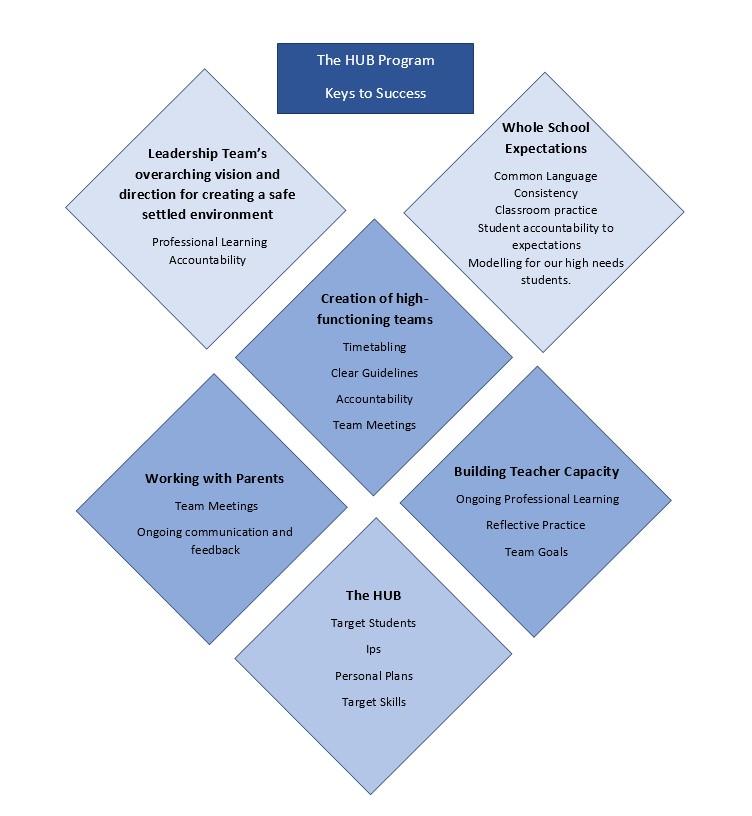
Feedback
- Staff were surveyed on how the HUB had benefited them. Over 90 per cent of staff surveyed believed the HUB program had highly supported them in their role. These responses included: “the students I work with are more settled with the routine at the HUB”; “the HUB program has contributed to improved behaviour across the school”, and “the HUB program has further enhanced the ‘team approach’ when dealing with challenging behaviours”.
- When teachers were asked if the HUB had been effective in supporting the students they worked with, 100 per cent of staff surveyed believed the HUB effectively supported the students. Responses included: “when (student) has her Hub routine she is more settled and compliant, it has increased her independence”; “the HUB provides the opportunity for teams to work together to identify the skills that are lacking and then develop a collaborative approach to building and practicing these skills with the ultimate aim being success in the classroom…. I feel our more challenging students are supported and understood, not judged”, and “the program provided students with the tools and strategies to assist them to self-regulate”.
- Students were surveyed asking how the morning check-ins at the HUB supported them with 100 per cent of those responding saying they found the HUB to be beneficial. Feedback included: “it helps me feel more calm and not as stressed”; “my routine helps me to be organised”; “makes school easier because it helps me to know how to meet new friends and know what to do in the classroom”, and “it takes my mind off my worries”.
- When parents were asked how the HUB had helped their child, 100 per cent of parents surveyed believed the program had supported families. Responses included: “(student) has become more of a happy person… he finds himself more organised for the day”; “after (student) attends the HUB he returns to class with his emotions regulated, stress levels are down and he can focus on the tasks for the rest of the day”, and “it has helped increased my son’s confidence… it has made him more settled for schoolwork and he communicates better overall with teachers and other students”.
- Since the full implementation of the HUB Program in 2021, the school has been offering professional learning experiences for staff from other schools and have had around 20 professionals visit the school to engage in professional learning sessions and observations of practice. A survey of attendees found the professional learning experience beneficial with 87.5 per cent believing it would significantly impact their practice and 14.3 per cent saying it would have some impact on their practice.
Implementation within other contexts
The HUB program is an initiative that has applications within any school context. St Patrick’s identified the following factors as contributing to the success of the program:
- clarity in terms of the school leadership team’s vision and direction for the school as a safe, settled learning environment in which student behaviour management was of high quality and priority
- clear, consistent and high expectations for behaviour, which included high-yield strategies and routines being embedded across the school K-6 to ensure quality student engagement
- professional learning for staff to ensure a common understanding of what constitutes quality student engagement
- high-functioning teams and ensuring each of the teams within the school are engaged in reflective practice to inform planning
- including support staff in team meetings and professional learning experiences
- modelling quality, positive engagement with parents to build relationships and trust
- working with teachers within classrooms and facilitated reflective practice to ensure that all teachers are maintaining high expectations and are holding students accountable.
Supporting videos
References
Autism Spectrum Australia (2023) Mental Health and Wellbeing. Retrieved from https://www.autismspectrum.org.au/uploads/documents/Fact%20Sheets/Aspect-Research-mental-health-wellbeing.pdf
Black Dog Institute (2021) Children’s Mental Health and Wellbeing. Retrieved from https://www.blackdoginstitute.org.au/wp-content/uploads/2021/08/20210525_Childrens-mental-health-and-wellbeing.pdf
Kids First (2023) Retrieved 19/5/23 from https://kids-first.com.au/australian-kids-anxiety-statistics/#:~:text=*%206.9%25%20of%20Australian%20kids%20are,Separation%20anxiety%20disorder
Further information
For those who wish to learn more about our programs or wish to engage in professional learning sessions please contact Principal Renae Dunleavy, St Patrick’s School, Lithgow via the website
